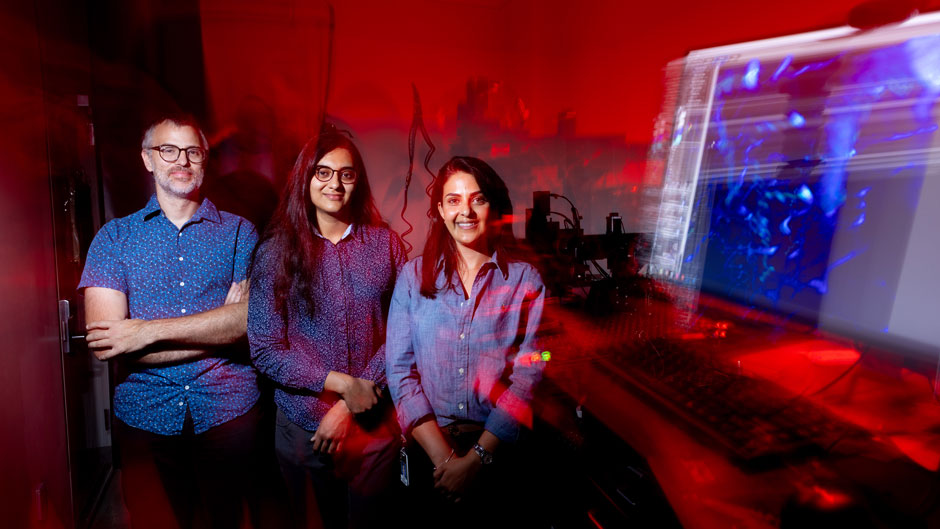When Oliver Bracko explains the complicated neuroscience of Alzheimer’s disease, it’s hard to imagine there was ever a time when he didn’t plan to attend college, let alone earn a Ph.D.
Bracko grew up in Germany at a time when the country’s education system separated children into three tracks: one destined for college and two bound for job training programs. As the child of factory workers, Bracko wasn’t encouraged to pursue higher education. He was partway into a three-year pastry chef training program when he decided he wanted to attend college. That meant convincing a school director to let him change tracks and enroll in high school.
“I needed to find a way to do my high school degree so that I could go to university,” explained Bracko, who is now an assistant professor in the Department of Biology at the University of Miami College of Arts and Sciences.
Bracko ultimately succeeded and went on to earn an undergraduate degree in biology. “Like many biology students at the beginning, I really wanted to understand disease,” he said.
This interest led Bracko to study neurodegenerative diseases and complete a master’s degree in neuroscience at the Salk Institute in La Jolla, California. While earning his Ph.D. at ETH Zurich, a university in Switzerland, he began researching inflammation and blood flow in the brain, including strokes and how they impact mental abilities. It wasn’t until Bracko moved to the United States in 2015 for a postdoctoral researcher position at Cornell University that he shifted his focus from strokes to the reduced blood flow and inflammation seen in the brains of Alzheimer’s patients.
Researchers have long known that Alzheimer’s patients have reduced blood flow in their brains, but the reasons why were not well understood. Bracko’s research indicates that one of the main causes of this reduced blood flow is a type of white blood cell called a neutrophil blocking capillaries, tiny blood vessels that deliver oxygen and nutrients to cells. When neutrophils temporarily block these blood vessels in the brain, causing inflammation and blood flow reductions, neurons don’t receive enough oxygen and nutrients, and there is less communication between them, which likely contributes to cognitive decline. Reducing this inflammation in the blood vessels could be a path toward new treatments.

With funding from the Alzheimer’s Association, Bracko is currently leading a study at the University that is focused on the role of neutrophils in Alzheimer’s disease.
Bracko and his research team, which includes doctoral student Zeynab Tabrizi and master’s student Nairuti Bhatt, are using a technique called single-cell sequencing to observe ongoing changes at the individual cell level. This allows the researchers to study differences between individual neutrophils in blood samples so they can determine which subpopulations of the cell are contributing to the progression of the disease.
“Neutrophils are heterogenous cells. We need to find out exactly which neutrophils are responsible,” Bhatt explained.
Understanding more about the role different neutrophils play in Alzheimer’s could lead to new treatments for a devastating disease that affects an estimated 6.9 million people in the United States alone.
“If we can inhibit this accumulation of neutrophils and improve brain blood flow, we can improve this cognitive decline in Alzheimer’s disease,” Tabrizi explained.
One of the challenges, however, is that neutrophils play a critical role in defending the body against viruses and bacteria, so any treatment that targets neutrophils could negatively impact a patient’s immune system. This is why it’s important to know which neutrophils are causing the blood vessel blockages seen in Alzheimer’s disease so that scientists can develop treatments that only target these cell populations.
“If it’s only a fraction of the neutrophils, it would leave the hope that it could be done,” Bracko said.
In Bracko’s lab, Bhatt and Tabrizi, who are both passionate about neuroscience, have found an ideal environment in which to pursue their research interests.
Tabrizi, who grew up in Iran, completed her master’s degree in immunology and studied neurodegenerative diseases at a research institute before joining Bracko’s lab in 2023. Bhatt, who is originally from India, earned her undergraduate degree from SUNY Albany and then worked on a research team that helped develop a saliva-based COVID-19 testing technique. After shadowing a pediatric neurosurgeon, Bhatt decided to focus on neuroscience, so she joined Bracko’s lab in 2023. In addition to working on the Alzheimer’s Association grant, both graduate students have also had the opportunity to develop their own research projects.

